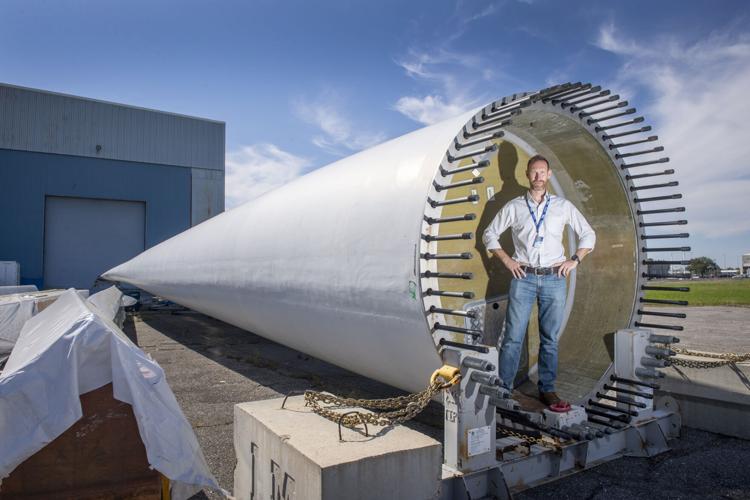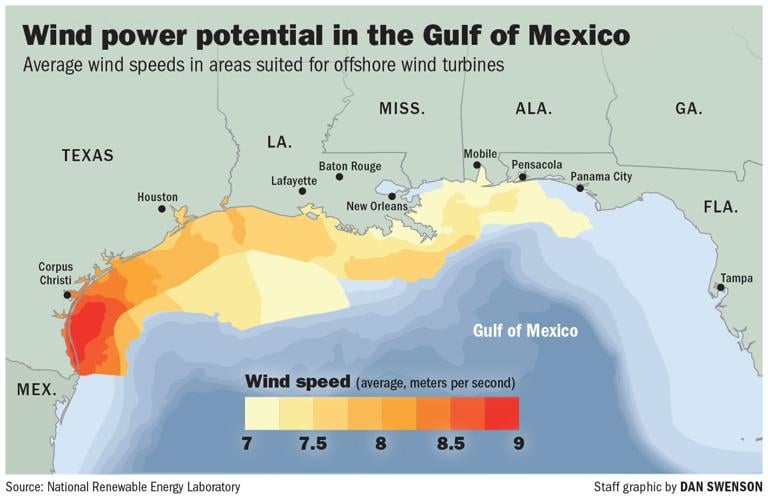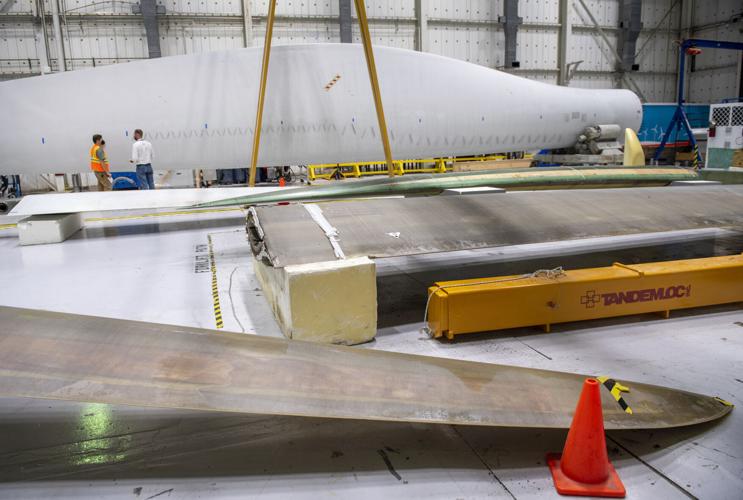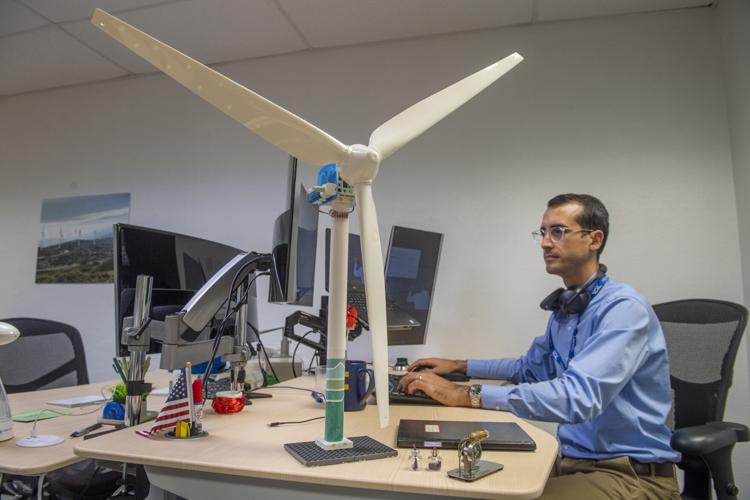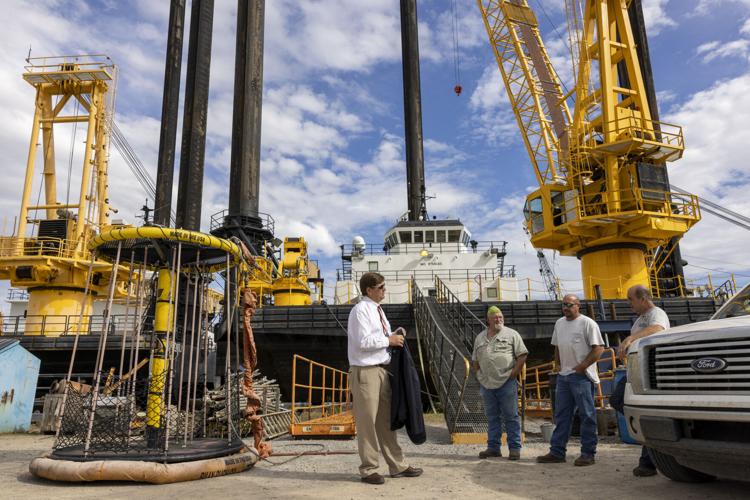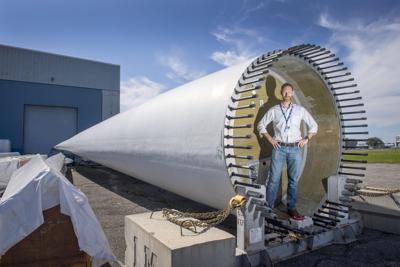In an old NASA building in New Orleans East, James Martin gently pats the side of an immense wind turbine blade that’s seen better days.
“This type of blade was the workhorse of the early 2000s,” he said of the scratched and mottled mass of fiberglass stretching half the length of a football field. Less than 20 years old, the blade is already a relic. “The blades we’re designing today are 2.5 times larger than this baby.”

Many of the recent technological strides that have allowed wind turbines to grow rapidly in size and efficiency have come out of this cavernous building in the Michoud Assembly Facility, a sprawling complex that built Saturn rockets and now has tenant innovators such as Martin’s company, LM Wind Power.
LM’s New Orleans facility is the only wind engineering technology center in the U.S. It has designed and tested blades bound for wind farms off the coasts of China, the United Kingdom, Massachusetts, New York. The list goes on...
“But nothing in Louisiana,” Martin said. “We’ve spent the past 10 years exporting ideas. We’d like to spend the next 10 years putting them in the Gulf.”

James Martin, senior director of blade platform deployment, looks at one of the blades being built at LM Wind Power at the Michoud Assembly Facility in New Orleans East on Oct. 26, 2021.
The Gulf of Mexico has long seemed an unlikely candidate for offshore wind development. Its winds are relatively weak until they reach hurricane strength, at which point they could be overpowering. While wind energy developers have swarmed across the East Coast in recent years, the Gulf has been largely ignored.
That is, until now. A recent federal study has recast the Gulf as a potential wind powerhouse. The National Renewable Energy Laboratory determined the Gulf has the potential to generate almost 510,000 megawatts of offshore wind energy per year. That’s twice the current energy needs of all five Gulf states, and larger than the potential offshore wind capacity of the Pacific Coast and Great Lakes combined.
In June, the U.S. Bureau of Ocean Energy Management, the federal agency that oversees offshore oil, gas and wind permitting, initiated a process that will open the Gulf to wind lease sales by 2025. Offshore wind companies from Singapore, Germany and Portugal and large oil companies such as Shell are already showing interest in building turbines off the Louisiana and Texas coasts.

“The Gulf is ripe for clean energy, and offshore wind is a really clear opportunity there,” agency Director Amanda Lefton said.
The region boasts three of the top four states with the highest offshore wind resource capacity, according to the laboratory's study, which was commissioned by the federal agency and released last year. While Massachusetts was the runaway leader, Florida, Texas and Louisiana came in second, third and fourth, respectively.
This story is the second in a series of five.
- Part 1: Louisiana oil workers built first U.S. offshore wind farm on East Coast. Can they do it on Gulf Coast?
- Part 2: The Gulf of Mexico is poised for a wind energy boom. 'The only question is when.'
- Part 3: Louisiana sent a 'strong signal' to offshore wind developers, but is it enough?
- Part 4: America's first offshore wind farm cut power bills, draws tourists
- Part 5: Trouble in the wind: Offshore turbine farms complicate fishing, shrimping
The Gulf makes up for its relatively weak winds with other attributes. Its shallow waters reduce the need for tall, expensive turbines, and its warm temperatures and smaller wave heights are expected to make construction and maintenance relatively easy and inexpensive, according to the study.
What truly sets the Gulf apart is its primed and ready workforce. Many of the skills needed in the offshore oil and gas industry are directly transferable to building and servicing wind farms.

Joseph Orgeron, left, stands in front of the lift boats that were used to install wind turbines in Rhode Island and talks to some of the south Louisiana crews who worked on that project: right to left, Jed Lorraine, Keith Randazzo and Kenneth Miers, all based in the Houma area.
“We have the most attractive full scope of abilities for offshore wind in the world,” Martin said. “It’s part of the DNA here to work offshore.”
Louisiana companies rooted in the oil and gas industry helped build the U.S.’s first offshore wind farm, a five-turbine pilot project that began operating off the coast of Rhode Island in 2016. The Block Island Wind Farm enlisted steel fabricators in Houma, ship operators from Galliano and engineers from Mandeville.
As the state’s oil and gas sector shrinks, many more companies that serviced oil rigs could find work in the offshore wind industry.
“There’s a lot of potential in the Gulf because the supply chain already exists,” said Michael Celata, the federal agency's Gulf region director. “It’s really a key facet for offshore wind’s future in the Gulf.”

From left to right, Ron Weicks, a general manager with Keystone Engineering; Dan Wardle, a civil engineer; and Richard Ekstrom, a project leader for renewable energies, talk Nov. 17, 2021, in an entryway at their Metairie office, where a yellow model and photos highlight the work they've done designing platforms for wind turbines, including the ones off Block Island, Rhode Island.
New wind farms would likely first pop up off the coast of Texas, which offers the Gulf’s best winds, but west Louisiana has some prime real estate in the shallow waters between Morgan City and the Texas line.
The laboratory's analysis included a hypothetical 600-megawatt wind project near Lake Charles. The relatively modest project, about a fourth the size of some of the projects proposed on the East Coast, could give a substantial boost to the region’s economy.
Initial construction would create about 4,470 jobs and generate $445 million in goods and services. Once constructed, the wind farm would support 150 jobs and an annual infusion of $14 million into the economy from operations, maintenance and materials.
Some offshore oil platforms might have a second life as wind energy substations or serve in other support roles. But the prospect of wind turbines tacked to old oil rigs is unlikely. Offshore structures weren’t designed to support towering and exceedingly heavy add-ons. Small turbines might work, but their energy output wouldn’t be high enough to justify their cost.

Jed Lorraine, left, smokes a cigarette as he stands at the end of a walkway with Keith Randazzo in Houma on Nov. 11 2021. Both men are captains of lift boats that were used to build the wind turbines off the coast of Rhode Island.
State business leaders are keen on the prospects of a diversified energy sector.
“We’re really, really excited about this,” said Michael Hecht, CEO of the economic development organization Greater New Orleans Inc. “It’s no exaggeration to say we’re at the onset of one of those rare moments before massive new investments that are going to change the U.S. economy in major ways.”
Louisiana Economic Development Secretary Don Pierson said offshore wind presents “a new frontier” for employment in a state that sorely needs it.
“The idea that there are thousands of jobs possible — that’s absolutely correct,” he said.

Pelicans nest on an island in Barataria Bay in 2015.
Hurricanes and birds
Offshore wind in the Gulf isn’t without challenges.
“The biggest question is hurricanes,” Celata said. The Gulf’s long and active hurricane season presents hazards unfamiliar to offshore wind developers in New England or the North Sea.
But with the fast pace of innovations in the industry, Celata is confident solutions are in the offing.
He points to the explosive growth of turbine sizes in recent years. Design innovations and materials upgrades have allowed turbines to grow beyond what was considered possible 20 years ago. The largest of the new breed of mega-turbines is GE’s Haliade-X, which was tested at LM’s New Orleans facility. At 853 feet tall, one Haliade-X can produce as much power as three Block Island turbines.
Engineers designed oil and gas structures that withstood Hurricane Katrina and other potent storms, so there’s no reason they can’t do the same for wind turbines, said Sara Ghazizadeh, of Keystone Engineering, the firm that designed the Block Island farm’s foundations.
“Hurricanes aren’t a challenge we can’t overcome,” she said. “By the time we need [turbines] in the Gulf, we’ll have it figured out.”
Engineers are developing blades that can collapse during hurricane-strength wind. Large floating turbines, already in use in Europe, could be towed into a harbor or out of a storm’s path, Celata said.
Birds are another big question. More than 2 billion birds cross the Gulf each year on a migratory pathway that follows the Mississippi River.
There’s no question some birds would be killed by spinning blades, said Erik Johnson, director of bird conservation science with the National Audubon Society's Delta office covering Louisiana, Mississippi and Arkansas. But climate change is harming far more birds than wind turbines ever will, he said.
“The bottom line is we have to get off oil and gas,” he said. Emissions from burning fossil fuels are at the heart of dramatic climate shifts that rob birds of habitat and harm their ability to breed, migrate and find food. “With more offshore wind, there will be a net benefit for birds.”

Erik Johnson checks for identification marks on a hummingbird.
There are worse threats to birds. House cats, for example, are blamed for killing about 2.4 billion birds each year. Automobiles knock out 200 million more, and pesticides poison at least 2.7 million birds each year in the U.S. “Wind energy will really be a drop in the bucket by comparison,” Johnson said.
Wind developers can take steps to reduce bird fatalities. They can limit the number of turbine lights, which tend to attract birds, and potentially shut down wind farms during peak migratory periods, Johnson said.
Offshore wind’s overlap with the fishing industry is an issue that’s already causing fights on the East Coast. Many fishers worry about turbines cluttering prime fishing areas, making large-net fishing more difficult and more dangerous.
Celata said whatever lessons and compromises that come out of the wind development process on the East Coast can be applied in the Gulf. He’s hopeful the transition will go more smoothly because the Gulf’s fishers are already used to plying their trade alongside thousands of oil and gas platforms.

Almost 50 turbines spin at a wind farm owned by the the German company RWE AG off the coast of Germany.
Growing interest
Despite the Gulf’s challenges, offshore wind developers are already circling the Gulf in search of opportunities.
Nine companies responded to the Bureau of Ocean Energy Management's request for interest in possible wind energy leasing in the Gulf. Five are from Europe, including Total Energies, of France, which has invested $60 billion in renewable energy projects over the past decade, and RWE, a German company that bills itself as the world’s second-largest operator of offshore wind.
“We believe in the long-term potential of the Gulf of Mexico region for offshore wind development,” RWE said in a letter to the agency. The company said the Gulf has prime natural conditions, “synergies with its well-established oil & gas sector” and Gov. John Bel Edwards’ strong political support for offshore wind.
Ocean Wind, a venture backed by Portugal’s largest energy supplier, pledged to “repurpose” large Gulf Coast fabrication and port centers for offshore wind projects in the region as well as for wind farms taking shape elsewhere in the country “where the local manufacturing and port facilities are not as robust.”

Lighting, far left, crackles over Block Island, Rhode Island, a few miles away from wind turbines in the Atlantic Ocean in September 2021. Several Louisiana companies helped build the Block Island Wind Farm, which started operations in 2016.
The Gulf’s largest oil driller might want to swap some of its rigs for turbines. Royal Dutch Shell, the biggest operator, lease holder, and producer of energy in the Gulf, wrote a particularly effusive letter about the prospects for offshore wind development.
“The Gulf of Mexico has a unique opportunity ... to lead the nation’s buildout of an integrated renewable energy basin, with offshore wind as a significant offshore energy generator,” wrote James Cotter, Shell’s vice president of wind development.
Shell said it's already getting its feet wet with offshore wind projects in New Jersey, New York and Massachusetts.
A smaller oil company, Houston-based Talos Energy, offered more stilted interest, asking for more clarity about future regulations and potential markets for wind energy.

Tomas Muchenik works next to a model of a wind turbine at LM Wind Power at the Michoud Assembly Facility in New Orleans East on Oct. 26, 2021.
Although unsure about the “economic demand for offshore power,” Talos is “keen to participate” in developing wind farms in several areas off the coast of Louisiana.
The federal agency initiated its second request for information and public input on Nov. 1. The agency hopes the process, which ends Dec. 1, will clarify where to focus offshore wind development.
Celata said the agency is expediting the Gulf leasing process to meet President Joe Biden’s offshore wind development goals.
It’s an “extremely aggressive” timeline, he said. “It’s a four-year process we’ve compressed into two.”
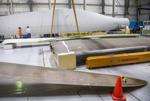
Blades crisscross the manufacturing floor at LM Wind Power at the Michoud Assembly Facility in New Orleans East on Oct. 26, 2021.
Federal lease planning could conclude by 2023, followed by a five-year site assessment process. Turbines might start spinning over the Gulf as early as 2028.
But a lot can change over the next decade. A future president might not push offshore wind the way Biden has, or might even oppose it, as President Donald Trump did.
But several industry watchers say offshore wind has built enough momentum — and is generating enough money — to push through most political obstacles.
“I guarantee this will happen in the Gulf,” said Martin, of LM Wind. “Every body of water will have offshore wind. It’s only a question of when.”
Turbines could start sprouting in waters off Louisiana and Texas within the decade
Live online panel discussion is scheduled Tuesday at 11 a.m.
This story is part of a Times-Picayune | New Orleans Advocate series on offshore wind energy and was supported by an MIT Environmental Solutions Initiative journalism fellowship.
Tristan Baurick is an environment reporter for The Times-Picayune | New Orleans Advocate. Email him at tbaurick@theadvocate.com and follow him on Twitter, @tristanbaurick.

James Martin, senior director of blade platform deployment, stands in one of the blades at LM Wind Power at the Michoud Assembly Facility in New Orleans East on Oct. 26, 2021.

